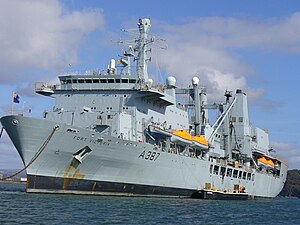This article needs additional citations for verification. (June 2008) |
 Fort Victoria
| |
| Class overview | |
|---|---|
| Name | Fort Victoria class |
| Builders |
|
| Operators | |
| Preceded by | Fort Rosalie-class replenishment ship |
| Succeeded by | Fleet Solid Support Ship Programme |
| Built | 1988–1991 |
| In commission | 1993–present |
| Planned | 6 |
| Completed | 2 |
| Cancelled | 4 |
| Active | 1 |
| Scrapped | 1 |
| General characteristics | |
| Class and type | Replenishment oiler |
| Displacement | 32,300 long tons (32,818 t) full load |
| Length | 203 m (666 ft 0 in) |
| Beam | 30 m (98 ft 5 in) |
| Draught | 10 m (32 ft 10 in) |
| Propulsion | 2 shafts, Crossley-Pielstick V-16 diesels, 23,904 bhp (17,825 kW) |
| Speed | 20 knots (37 km/h; 23 mph) |
| Complement | 95 RFA / 15 RN / 154 FAA / 24 RNSTS civilians |
| Sensors and processing systems |
|
| Electronic warfare & decoys | |
| Armament | |
| Aircraft carried | Up to 5 × Sea King or Merlin helicopters (3 in hangar) |
The Fort Victoria or Fort II class is a class of replenishment oiler of the Royal Fleet Auxiliary, a role that combines the missions of a tanker and stores supply ship.[3] As such they are designated auxiliary oiler replenisher (AOR). They are tasked with providing ammunition, fuel, food and other supplies to Royal Navy vessels around the world. There were two ships in the class, Fort Victoria and Fort George; the latter being taken out of service and despatched for scrapping at a Turkish breakers as a consequence of budgetary cutbacks.
- ^ "New navigation radar system for Royal Navy". Government of the United Kingdom. 28 January 2016. Retrieved 20 August 2020.
- ^ "Duke (Type 23) class Frigate". Seaforces - online. Retrieved 29 March 2023.
- ^ "RFA Fort Victoria". Royal Navy. Retrieved 22 December 2011.